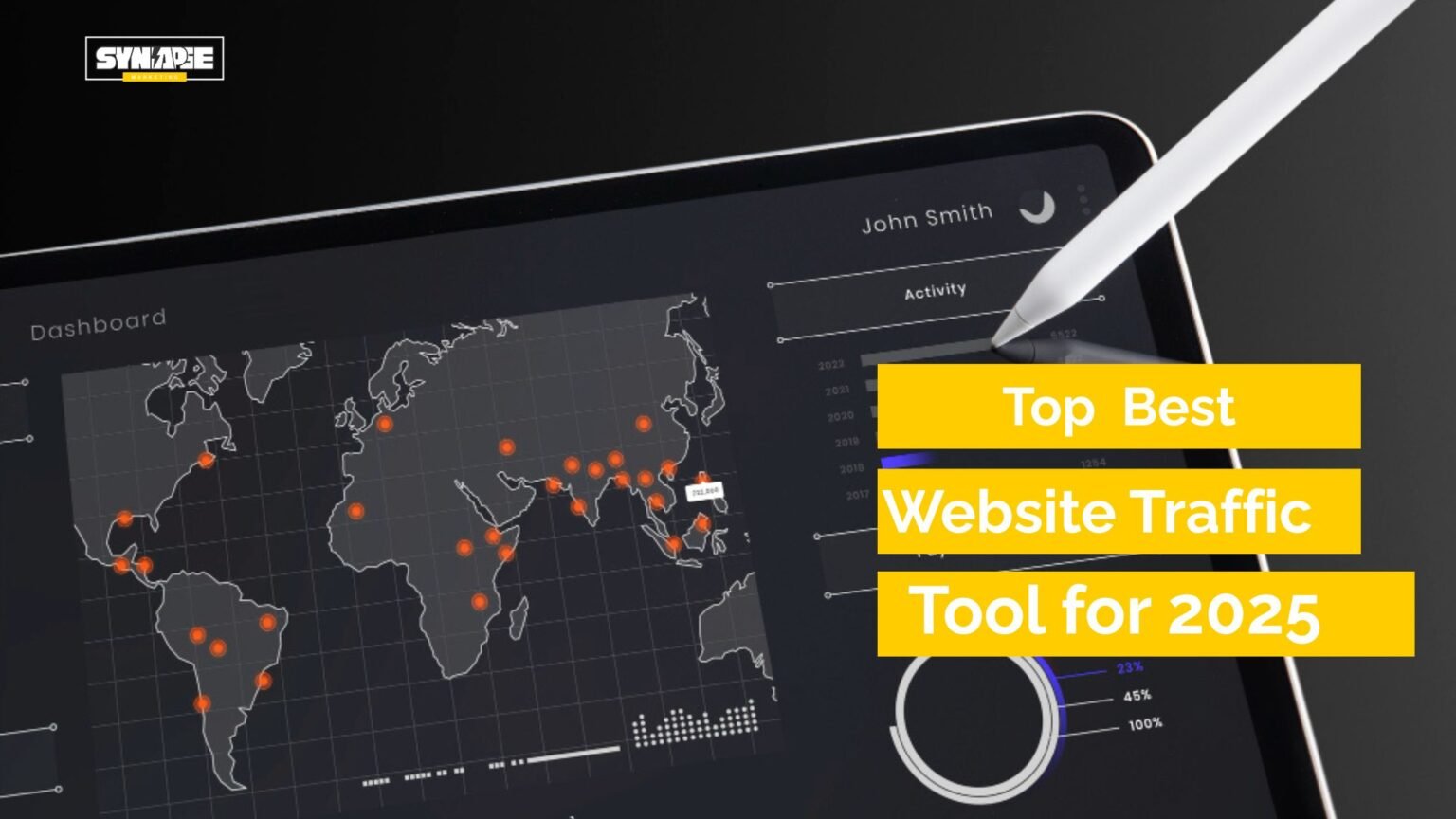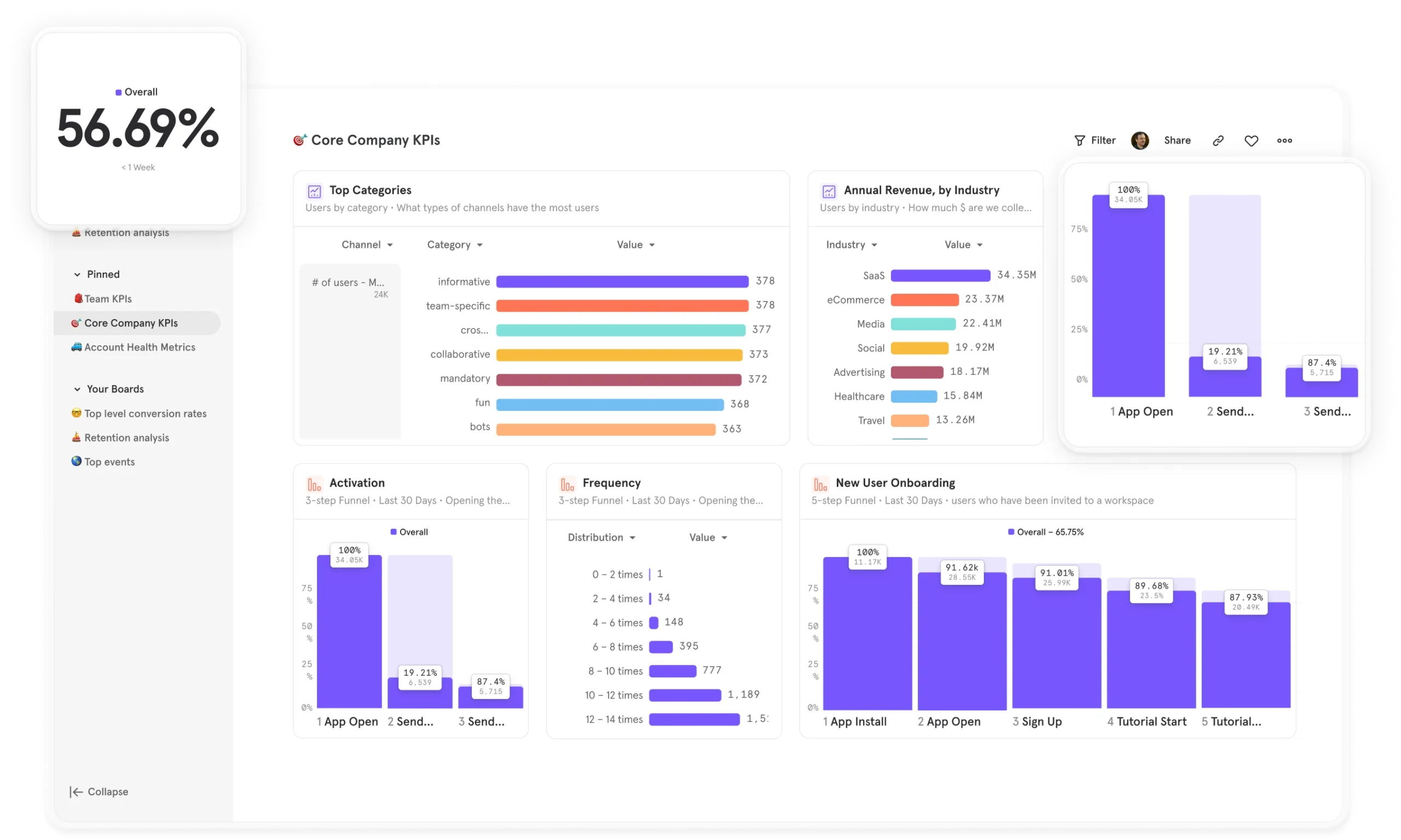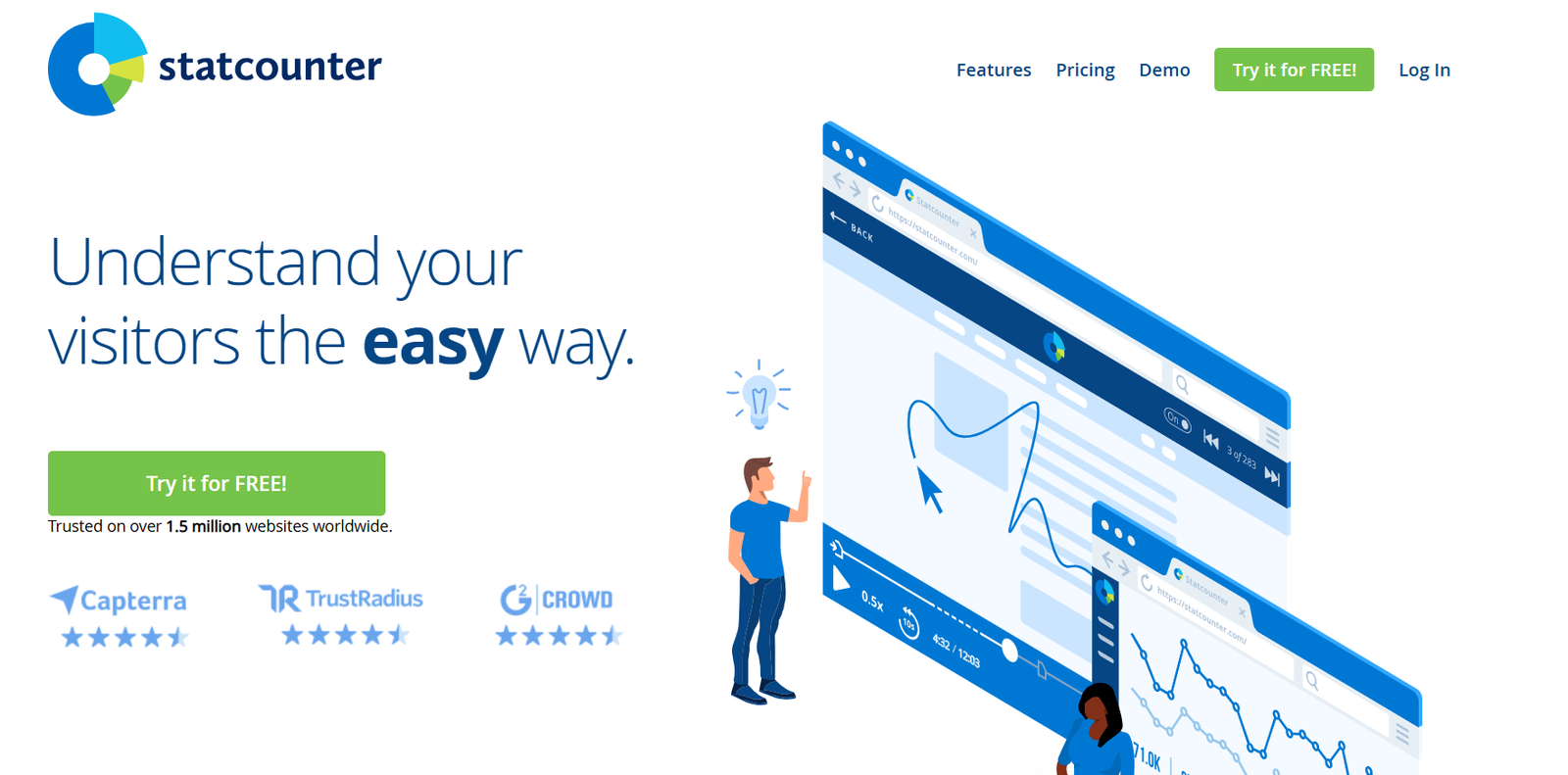If you’re serious about growing your website, you need more than just content and keywords—you need data. And not just any data. I’m talking about real-time, actionable insights that show where your visitors come from, what they’re doing, and where you’re losing them. That’s where the best website traffic tool comes in.
Over the past decade, I’ve tested everything—from free tools like Google Analytics 4 to more advanced platforms like Semrush, Ahrefs, and Similarweb. What I’ve learned is this: if you’re not measuring traffic correctly, you’re not optimizing anything.
A good website traffic tool helps you understand the “why” behind your traffic spikes, bounce rates, and conversion drops. It’s not just about counting visitors. It’s about tracking the full journey—from first click to conversion—so you can improve performance, plan your content smarter, and make strategic decisions backed by data.
This guide is built to help you choose the best website traffic tool for your business—whether you’re running a blog, an e-commerce store, a SaaS platform, or a lead-gen site. I’ll walk you through the top tools, their features, pros, cons, and when to use each.
Forget guesswork. With the right analytics tool in place, you’ll stop reacting and start anticipating. Let’s get into it.
What Is a Website Traffic Tool?
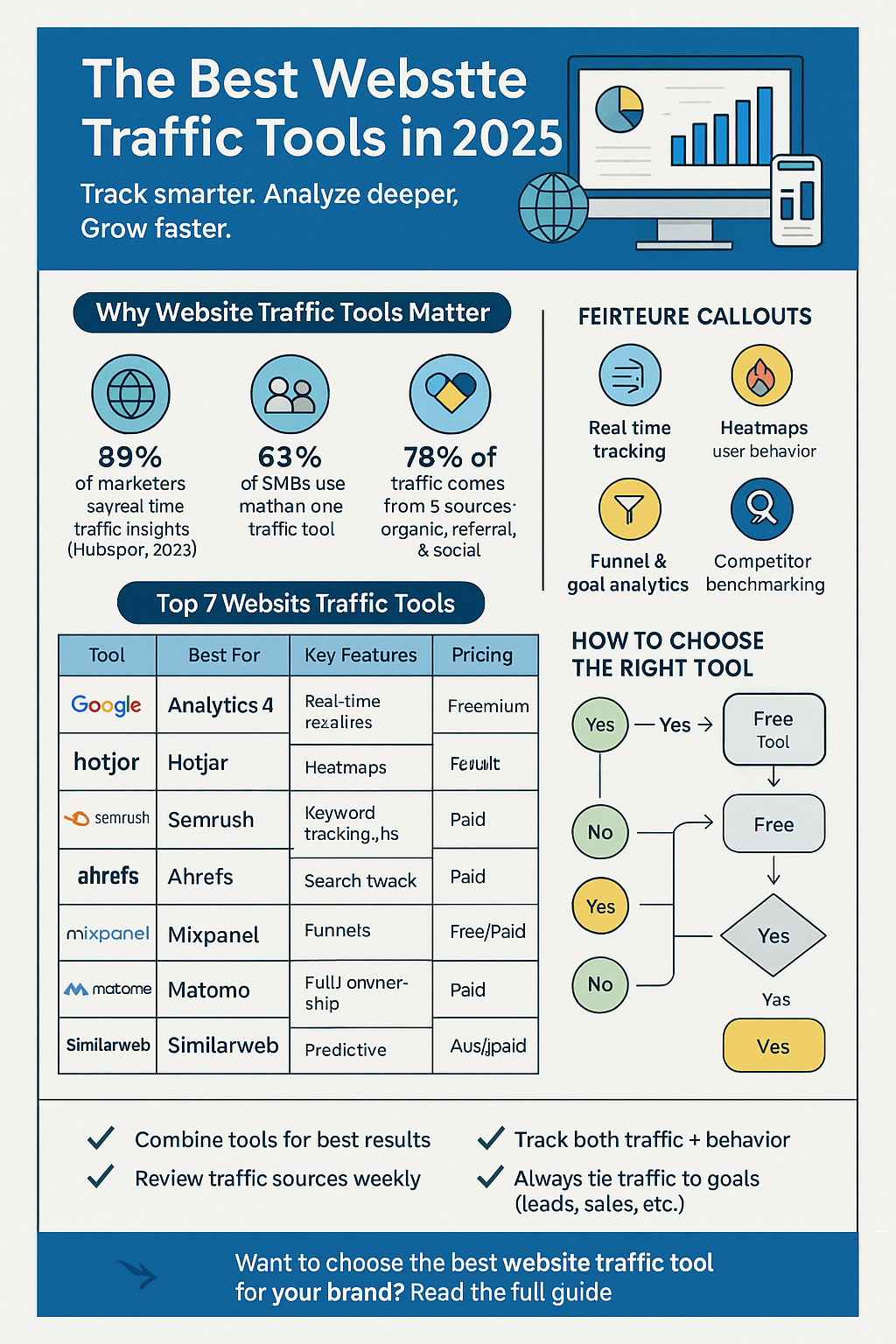
A website traffic tool is software that tracks how users find, interact with, and navigate your website. Sounds basic, but it’s the foundation of everything from SEO strategy to conversion optimization.
At its core, this kind of tool shows you how many people visit your site, where they come from (organic, paid, referral, direct, social), what pages they view, how long they stay, and what actions they take before leaving or converting. That’s your digital footprint—and if you’re not measuring it, you’re operating blind.
There are two broad categories of tools:
- First-party analytics tools like Google Analytics 4 or Matomo, which collect user data directly from your site.
- Third-party traffic analysis platforms like Similarweb or Ahrefs, which estimate traffic across the web using external data sources.
Some tools, like Mixpanel or Hotjar, go a step further by showing user behaviors in real time—things like scroll depth, clicks, session recordings, and even rage clicks.
The best website traffic tools do more than spit out numbers. They help you ask better questions:
- Why is my bounce rate high on mobile?
- Which landing pages convert the best?
- What content brings in qualified visitors?
- Where am I losing traffic to competitors?
I rely on these insights to prioritize SEO tasks, refine ad targeting, and improve site speed. Without that feedback loop, you’re just guessing. And guessing doesn’t scale.
If you’re building traffic and care about results, learning to use a website traffic analysis tool isn’t optional—it’s a competitive advantage.
1. Google Analytics 4 (GA4) – The Standard Free Tool
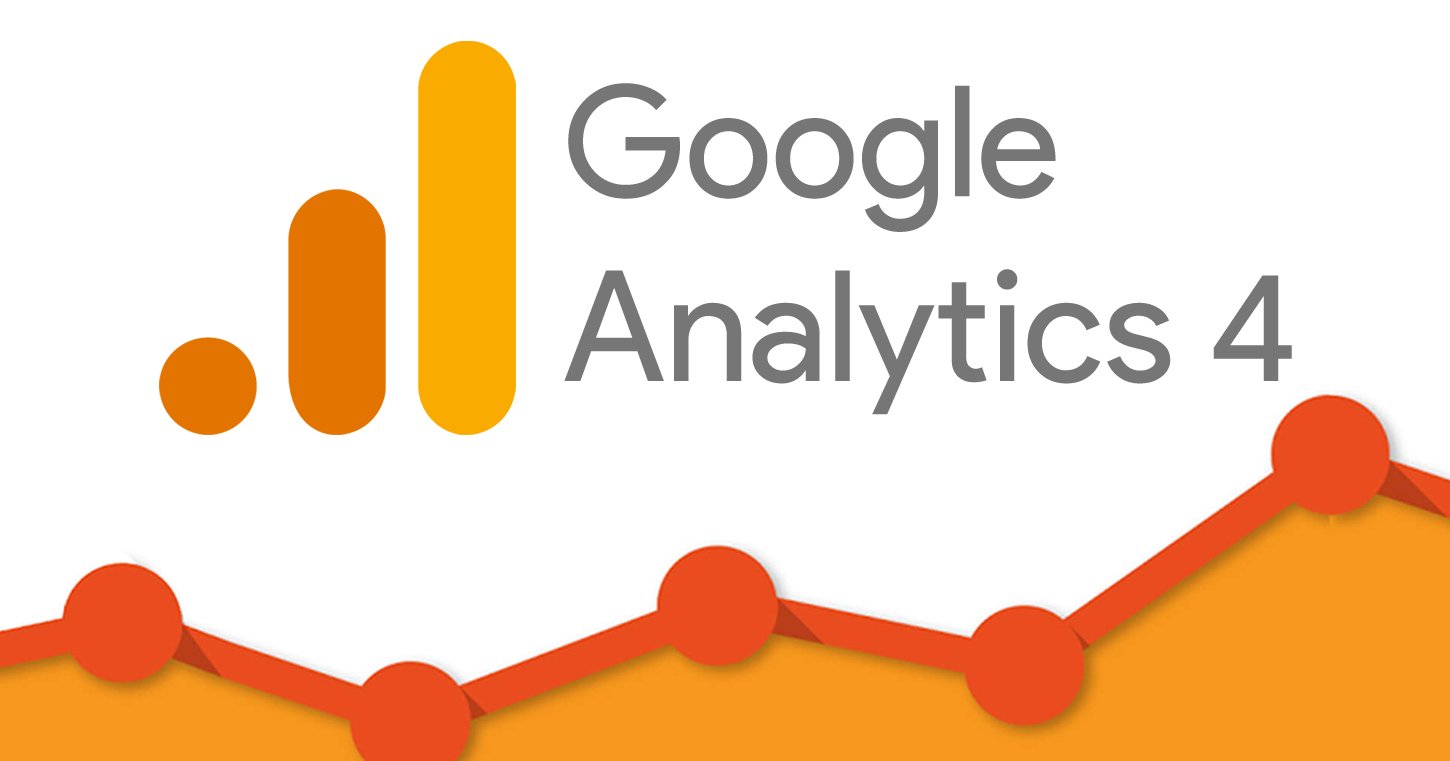
When people ask me where to start with traffic analysis, I point them straight to Google Analytics 4. It’s the best website traffic tool if you want a free, flexible, and scalable solution that gives you a full view of how people interact with your site.
GA4 tracks core traffic metrics sessions, users, bounce rates, average time on page, traffic sources and connects them to actual user behavior. It’s designed around events rather than pageviews, which means it tracks actions like clicks, scrolls, and conversions out of the box.
One of the most valuable features is audience segmentation. I can isolate returning users, organic search traffic, or visitors who converted, then build lookalike audiences for retargeting in Google Ads. GA4 also integrates seamlessly with Google Search Console and Google Tag Manager, giving you more control over data collection and analysis.
Is it perfect? No. The learning curve is steep, especially if you’re coming from Universal Analytics. The reporting interface is less intuitive, and setting up conversions (now called events) can be frustrating at first. But once you get past that, the insights are incredibly powerful.
I recommend GA4 for every website, even if you plan to use other tools like Semrush or Ahrefs alongside it. It captures first-party data directly from your site, which makes it more accurate and privacy-compliant than most third-party platforms.
For site owners serious about tracking growth, GA4 isn’t optional—it’s the foundation.
2. Semrush – Best for Competitive Website Traffic Analysis
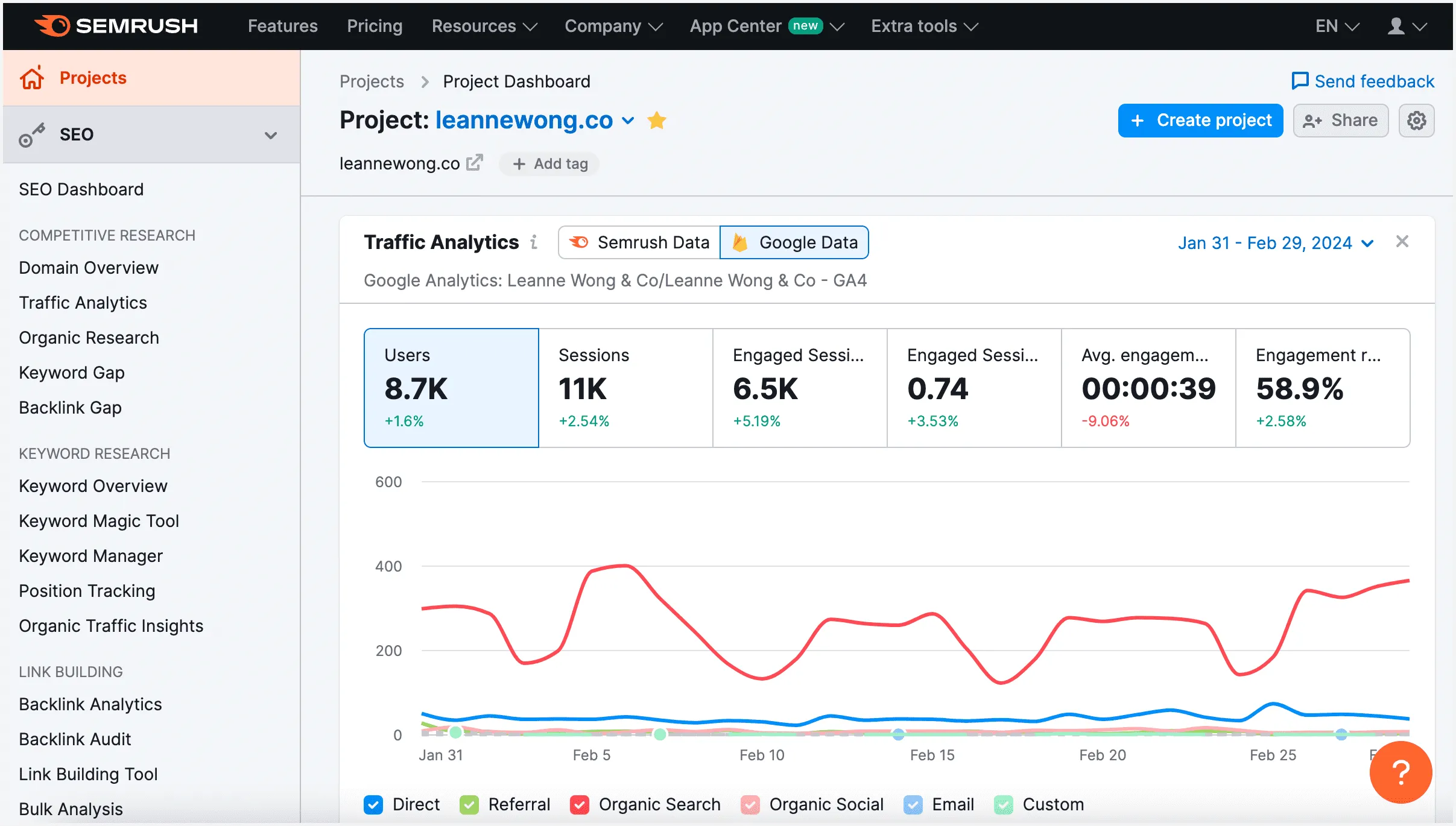
If you want to go beyond your own site and dig into your competitors’ performance, Semrush is the best website traffic tool for the job. I’ve used it for years to reverse-engineer traffic strategies and identify keyword gaps that would otherwise take weeks to uncover manually.
What makes Semrush stand out is its Traffic Analytics tool. It estimates traffic volume for any domain, yes, even your competitors’ and breaks it down by country, traffic source, desktop vs. mobile, and more. You can see top referring domains, audience overlap, and even user behavior trends like average visit duration or pages per session.
From an SEO standpoint, Semrush is unmatched. Its Organic Research tool shows which keywords a domain ranks for, how much traffic those keywords drive, and how rankings change over time. If you’re planning a content strategy or optimizing landing pages, this intel is gold.
Where it shines most, though, is competitive benchmarking. I’ve used it to identify where a competitor’s traffic is coming from—whether it’s paid ads, backlinks, or high-performing blog content. That insight lets me make smarter decisions on where to focus my own effort.
Semrush isn’t free. As at the date of this publication, plans start around $117/month, which may be steep for small businesses. But for agencies, SEOs, and marketers who rely on traffic data to grow, it pays for itself quickly.
If you’re looking for a website traffic tool that goes beyond basic analytics and into deep strategic insights, Semrush is one of the most powerful platforms available.
3. Ahrefs – Quick Domain Traffic Estimator
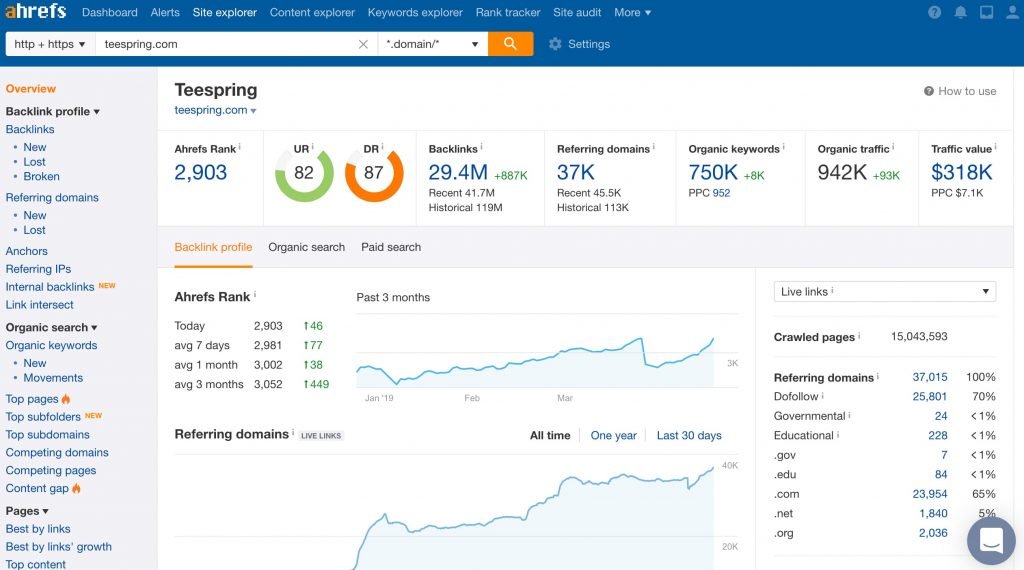
When I need fast, accurate insight into how a competitor’s website is performing, I reach for Ahrefs. While it’s best known as a backlink and keyword tool, its Site Explorer and Traffic Checker features make it a strong contender for the best website traffic tool, especially for SEOs and content strategists.
Ahrefs estimates organic traffic for any domain or URL, using its massive keyword index to calculate how much search visibility a site has. You’ll see traffic volume, keyword rankings, backlink profiles, and even the top-performing content—all in one clean dashboard.
What sets it apart is how quickly I can uncover what’s working for other websites. Within minutes, I can tell which pages bring in the most organic traffic, which keywords drive clicks, and which backlinks contribute to search authority. That’s not just data—it’s a blueprint for content strategy.
While Ahrefs doesn’t offer real-time or user-specific traffic metrics like GA4, it gives you what most tools can’t: a high-level view of how a site performs in search. That’s incredibly useful when analyzing competitors or auditing your own domain health.
Ahrefs is not cheap, with pricing starting around $99/month. It also lacks built-in integrations like ad campaign data or heatmaps. But if you want an SEO-focused website traffic analysis tool that reveals what Google sees, Ahrefs is a weapon I wouldn’t go without.
In short, Ahrefs is the go-to for understanding why a page ranks—and how to outrank it.
4. Similarweb – Best for Market Intelligence
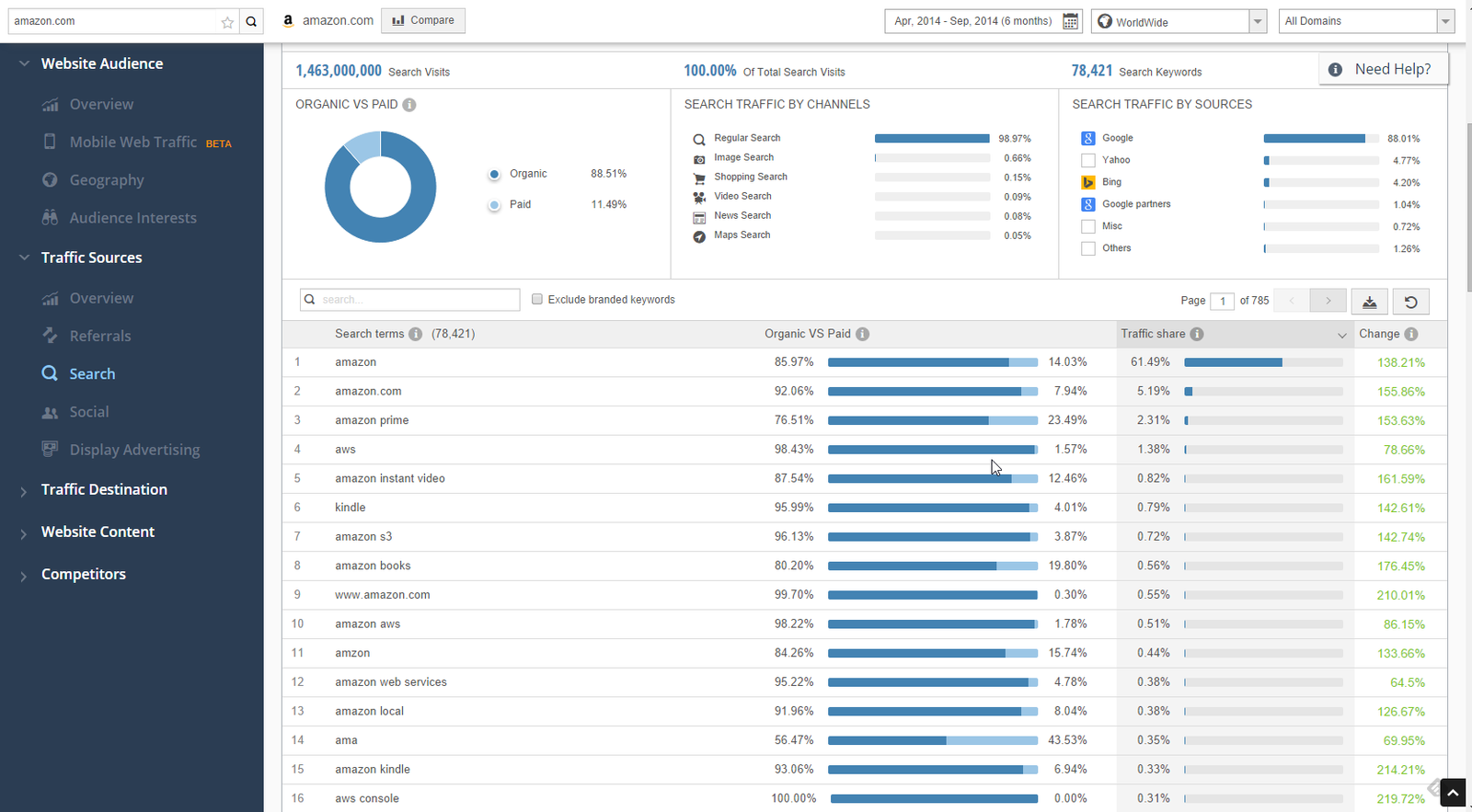
When I need a bird’s-eye view of an industry—beyond just SEO—I turn to Similarweb. It’s not just a traffic checker. It’s a full-fledged market intelligence platform that shows you how websites attract, engage, and retain their audience at scale.
What makes Similarweb one of the best website traffic tools available today is its ability to break down traffic sources across millions of sites. You can see how much of a competitor’s traffic comes from organic search, paid ads, social media, referrals, or direct visits—all organized in a clean, visual format. If you’re running paid campaigns, affiliate traffic, or content partnerships, that insight is invaluable.
But where Similarweb really shines is category-level analysis. For instance, I can compare multiple e-commerce sites in the same vertical, view total monthly traffic trends, bounce rates, and even see the top-performing pages or marketing channels they use to scale.
It’s especially useful if you’re in a competitive industry and want to benchmark against market leaders. Planning a new campaign? Similarweb helps you spot high-performing content strategies and even traffic dips your competitors don’t want you to see.
The free version gives a basic overview, but for deeper data, you’ll need a paid plan—starting around $125/month. It’s worth it if you’re managing multiple sites or working in digital strategy.
Whether you’re analyzing market trends, scoping out a new niche, or just spying on competitors, Similarweb is an elite tool with unmatched breadth.
5. Matomo – Open-Source, Privacy-Focused Option
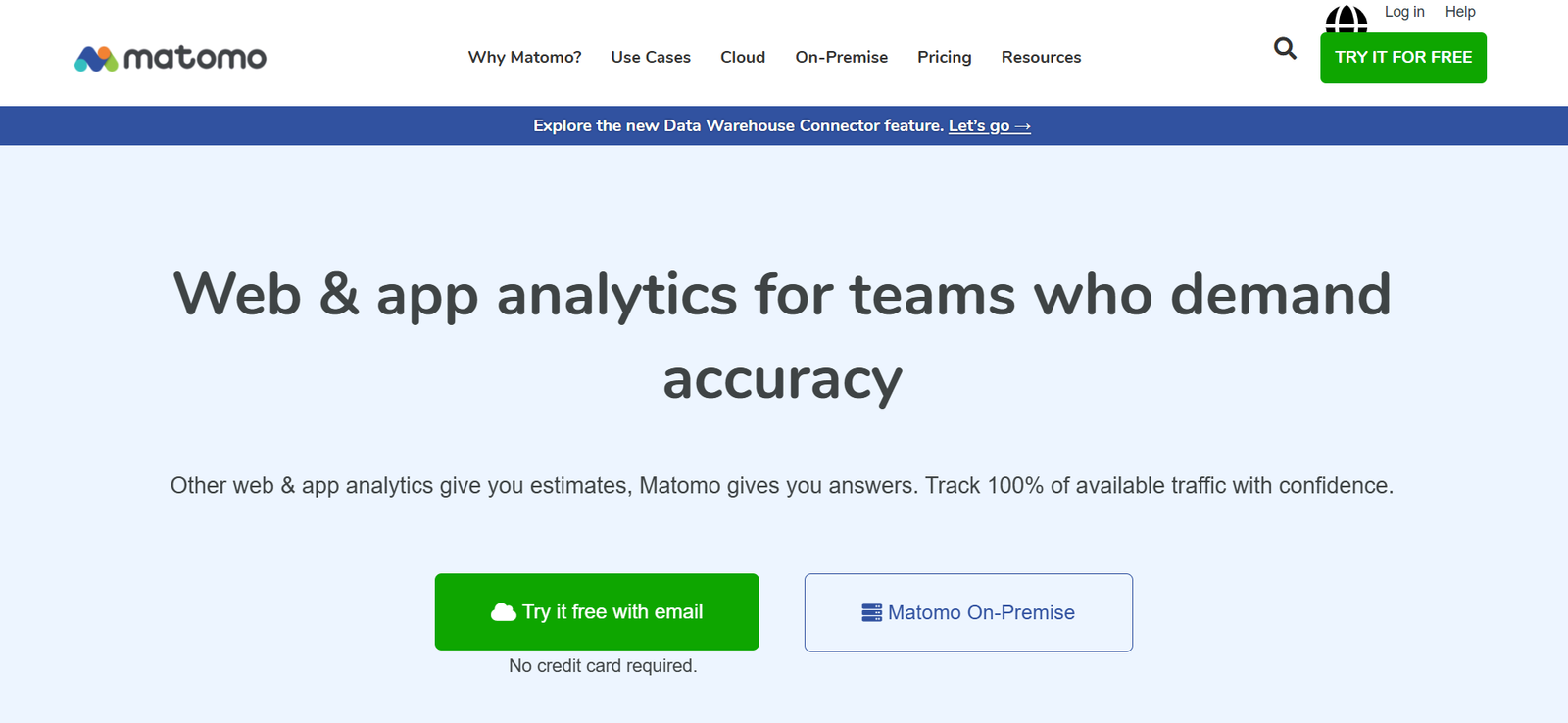
If data privacy is a top concern for your business or your users Matomo is the best website traffic tool you’re probably not using yet. It’s an open-source, GDPR-compliant alternative to Google Analytics that gives you full ownership of your data.
Unlike third-party platforms that collect and store user data on their own servers, Matomo lets you self-host analytics on your own infrastructure. That means you control what’s collected, how it’s stored, and who can access it. For clients in healthcare, government, or education sectors, this has been a game changer in meeting compliance standards.
Matomo tracks all the core traffic metrics you’d expect—unique visitors, session duration, bounce rates, conversion goals—and includes advanced features like heatmaps, session recordings, A/B testing, and form analytics. What impressed me most is that it doesn’t sample your data like Google Analytics often does. You get 100% of your traffic records.
If you don’t want to deal with server-side installation, Matomo Cloud offers a fully hosted version with premium support and maintenance.
It’s not as polished as tools like GA4 or Similarweb, and the interface can feel clunky at times. But the tradeoff is worth it if transparency, security, and ethical tracking are high on your list.
Pricing for the cloud version starts around $23/month, while the on-premise version is completely free. That makes Matomo one of the most accessible and flexible website traffic analysis tools out there—especially for privacy-conscious organizations or developers who want more control.
6. Mixpanel – For Product & Funnel Analysis
If you’re building a SaaS platform, mobile app, or digital product, you’ll quickly realize that traditional analytics like pageviews and bounce rates just don’t cut it. That’s where Mixpanel comes in. It’s not your average traffic tool—it’s a product analytics platform, and for tracking user actions across a journey, it might be the best website traffic tool for product teams.
Unlike tools that focus purely on website traffic volume, Mixpanel is built around event tracking. Want to know how many users clicked a specific button, activated a feature, or completed onboarding? Mixpanel can track all of that in real time, with the flexibility to segment users based on behavior, location, device, or referral source.
One of my favorite features is the funnel analysis. I use it to visualize where users drop off in key workflows, like checkout or registration flows. You can also build retention cohorts and monitor how engagement changes over time. This is gold for product optimization and growth experiments.
Mixpanel integrates well with your tech stack—whether you’re running a React app, a WordPress site, or using tools like Segment or Zapier for automation.
It’s free for up to 20M monthly events, with paid plans starting around $140/month per 1.5M event volume. The interface is clean, fast, and built for actionable insights, not vanity metrics.
If you care less about how users arrive and more about what they do once they’re in, Mixpanel delivers where most website traffic tools fall short. It’s ideal for teams who want deeper product insights, not just surface-level stats.
7. Ubersuggest – Affordable Website Traffic Checker
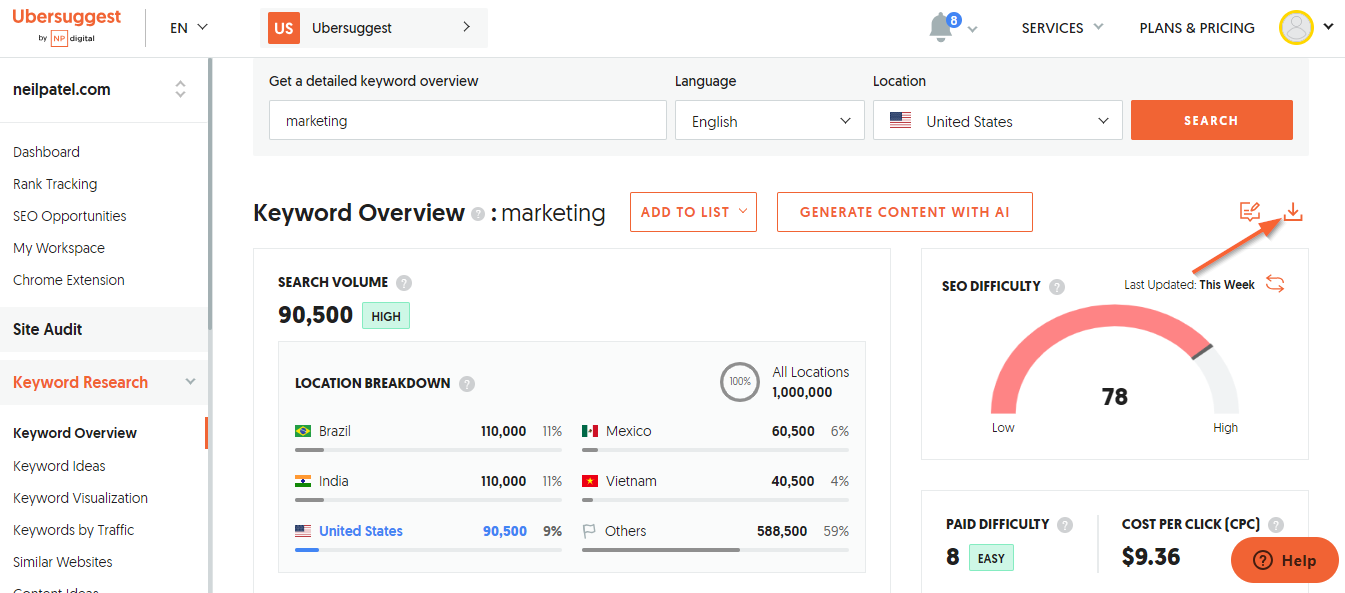
If you’re looking for an affordable, beginner-friendly website traffic analysis tool, Ubersuggest deserves your attention. Created by Neil Patel, this platform has grown from a basic keyword suggestion tool into a capable suite that covers SEO, backlinks, and traffic estimates—all at a price point most solo creators or small businesses can manage.
I often recommend Ubersuggest to clients who are just starting out. It lets you plug in any domain and get a high-level view of organic traffic, top-performing pages, keyword rankings, and backlinks. While it’s not as deep as Semrush or Ahrefs, the interface is far less intimidating and perfect for quick competitive checks.
What makes it one of the best website traffic tools for early-stage marketers is its balance between price and features. For around $20/month—or a one-time lifetime deal—you get access to historical keyword data, daily rank tracking, and site audits. Plus, it includes a traffic overview for competitors, so you’re not flying blind when benchmarking.
I’ve used it for blog content planning, keyword research, and identifying backlink opportunities that actually move the needle. It even offers helpful SEO suggestions right in the dashboard.
That said, Ubersuggest’s data isn’t as granular or frequently updated as some premium platforms, and the traffic estimates can be off by a margin. Still, for the cost, it delivers impressive value.
If you’re on a budget but want a reliable website traffic checker to fuel your SEO strategy, Ubersuggest is a smart way to get started.
8. Statcounter – Simpler Visitor Tracker
Sometimes, you don’t need all the bells and whistles—you just need to know who’s visiting your site and what they’re doing. That’s where Statcounter comes in. It’s one of the simplest and most user-friendly options in this lineup, and for many small business owners I work with, it’s the best website traffic tool to get started without feeling overwhelmed.
Statcounter gives you a live, real-time view of who’s on your site. You’ll see where they came from, what pages they’re viewing, how long they stay, and what actions they take. It’s all presented in a straightforward dashboard that doesn’t require any technical know-how to interpret.
The standout feature is visitor path tracking. I can follow a single user’s journey through a site—page by page—and understand where they exited. That kind of insight is powerful for troubleshooting UX issues or figuring out why people aren’t converting.
It also logs IPs, browser types, and device info, which can be useful for spotting patterns in repeat traffic or identifying spam behavior. There’s no complex setup—just copy and paste the tracking code into your site, and you’re live.
Statcounter isn’t ideal for large sites or advanced marketing funnels. It lacks detailed segmentation, integrations, and predictive insights. But for simple, direct tracking—especially for blogs, portfolios, or local business sites—it’s a dependable website traffic checker that delivers clarity without clutter.
The basic plan is free, with premium starting at $9/month. If you value simplicity and speed over depth, Statcounter is a tool worth exploring.
9. Hotjar – Behavior-Focused Tracking Tool
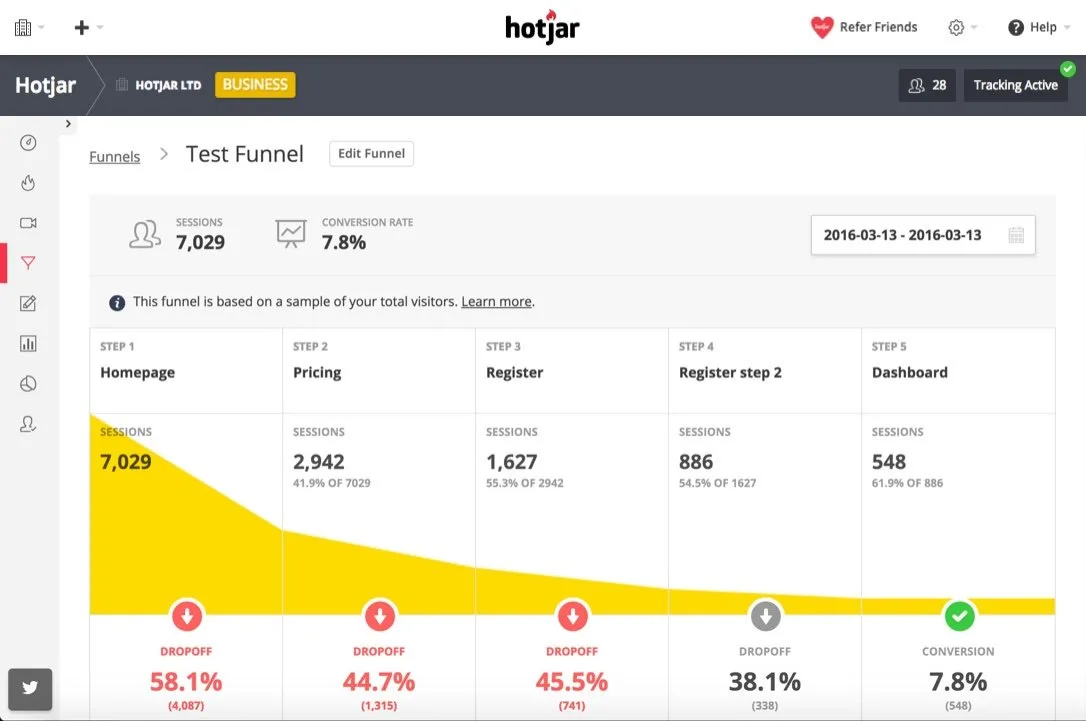
Numbers are great, but if you want to see how people are using your site, Hotjar is hands-down one of the best website traffic tools for visual behavior tracking. It goes beyond metrics like bounce rate or session duration and shows you what users actually do—where they click, scroll, and stop paying attention.
I’ve used Hotjar to uncover broken CTAs, confusing layouts, and drop-off points that analytics tools just can’t explain. It uses heatmaps, session recordings, and user feedback tools to deliver insights that drive UX improvements and better conversion rates.
What makes Hotjar special is how intuitive it is. With just a snippet of code, you can start capturing real-time user journeys. You’ll see recordings of mouse movements, clicks, and page scrolls. For anyone running A/B tests, this data is gold—especially when paired with tools like Google Optimize or Unbounce.
The feedback tools, like surveys and incoming feedback widgets, help you collect qualitative insights directly from users. I’ve used this to guide redesigns, improve navigation, and uncover messaging issues that analytics didn’t catch.
Hotjar doesn’t focus on traffic volume or SEO stats—it’s a behavior analytics tool, and it’s best used in tandem with something like GA4 or Similarweb. But when it comes to understanding why users act the way they do, it’s one of the most insightful platforms out there.
The free plan is generous, and paid plans start at $32/month. For conversion optimization and user research, Hotjar is a staple in my toolkit.
Conclusion: Which Website Traffic Tool Is Right for You?
Here’s the honest truth—there’s no one-size-fits-all best website traffic tool. The right platform depends on your goals, your team, your budget, and the kind of data you actually need to grow.
If you’re an SEO strategist or a digital marketer obsessed with keyword rankings and competitive analysis, Semrush or Ahrefs are hands-down the most powerful options. They give you deep insight into organic traffic, backlinks, and search intent that can shape your entire content strategy.
If you’re running a SaaS product or mobile app and care more about feature usage than traffic sources, Mixpanel is your go-to. For ecommerce and conversion tracking, Google Analytics 4 remains essential—though pairing it with something like Hotjar gives you the “what” and the “why” behind user behavior.
Need clean dashboards and enterprise-level support? Similarweb or Matomo offer scalability and privacy in equal measure. On a tight budget or just starting out? Ubersuggest or Statcounter deliver solid value without the steep learning curve.
Here’s how I see it:
- Use Google Analytics and Hotjar for a foundational, behavior-plus-metrics combo.
- Layer in Semrush or Ahrefs if you’re serious about SEO and growth.
- Plug in Mixpanel if you need product-level insights.
- Choose Matomo if data privacy is non-negotiable.
Each tool offers a different lens on your traffic. The magic happens when you align that lens with your goals—and use the insights to actually take action.
In my experience, the best website traffic tool is the one you’ll consistently use, understand, and integrate into your workflow. That’s what turns traffic data into business results.
Frequently Asked Questions on Best Website Traffic Tool
What is the best website traffic tool for beginners?
If you’re just getting started, I recommend Ubersuggest or Statcounter. Both are easy to use, affordable, and offer the essential metrics—like visitor counts, top pages, and traffic sources—without overwhelming dashboards or jargon. They’re perfect for learning the ropes.
Can I track real-time traffic for free?
Yes. Google Analytics 4 and Statcounter both offer real-time tracking in their free versions. GA4 shows you live users, pages viewed, and engagement metrics, while Statcounter displays individual visitor paths and behavior as it happens. They’re solid tools for immediate insight.
What’s the difference between website traffic tools and SEO tools?
Website traffic tools focus on measuring and analyzing who visits your site, from where, and what they do once they arrive. SEO tools like Ahrefs or Semrush help you improve your visibility in search engines by analyzing keywords, backlinks, and competitor strategies. There’s overlap, but they serve different goals.
Which tool is best for eCommerce websites?
For eCommerce, GA4, Hotjar, and Mixpanel make a powerful trio. GA4 gives you product-level analytics and conversion data, Hotjar shows user behavior visually, and Mixpanel lets you track the entire customer journey post-click. Together, they give you both macro and micro views of user activity.
Is there a free website traffic tool with accurate data?
While no tool gives you perfectly accurate traffic data, Google Analytics is the most reliable free option. It’s widely trusted, supported, and integrates with other Google tools. For privacy-focused sites, Matomo offers a great open-source alternative with accurate visitor metrics.
Can I see competitor traffic using these tools?
Absolutely. Tools like Semrush, Ahrefs, and Similarweb let you spy (ethically) on your competitors’ traffic volumes, top pages, referral sources, and keyword rankings. While estimates vary, they provide a strong directional sense of where your competition is gaining ground.





